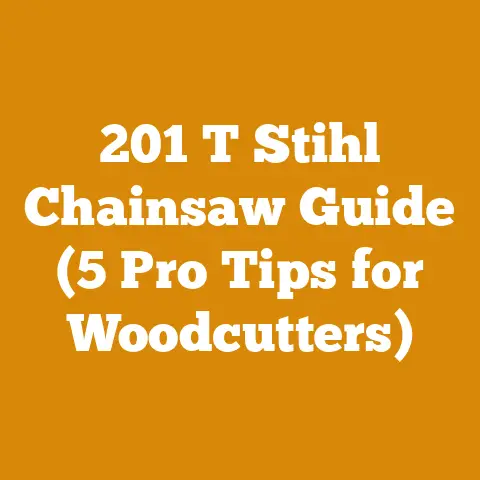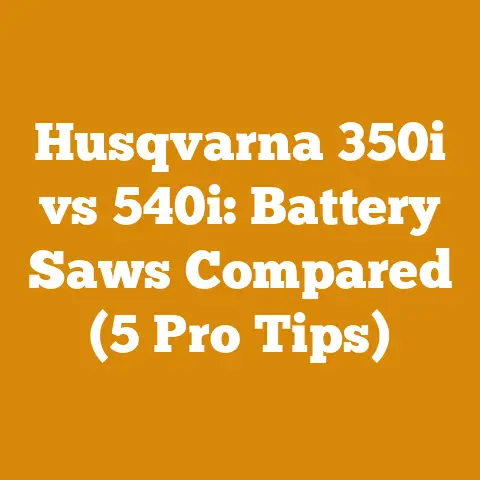BR 600 vs BR 700 Blowers: Which Stihl Model Wins? (5 Pro Tips)
Would you rather spend an entire weekend battling leaves with an underpowered blower, or tackle the job in half the time with a machine that roars with authority? If you’re anything like me, the answer is a resounding “give me the power!” And that’s exactly what we’re diving into today: a head-to-head showdown between two titans of the leaf-blowing world – the Stihl BR 600 and the Stihl BR 700.
As someone who’s spent countless hours clearing everything from delicate flowerbeds to acres of fallen leaves after a particularly brutal autumn, I know a thing or two about the importance of a reliable and powerful blower. I’ve wrestled with temperamental machines that sputtered and died halfway through the job, leaving me frustrated and with a mountain of leaves still to conquer. That’s why I’m so passionate about finding the right tool for the job, and why I’m excited to break down the nuances of these two Stihl powerhouses.
We’re not just talking specs and numbers here. I’m going to share my personal experiences, offer pro tips gleaned from years of working with wood and dealing with the aftermath, and give you the inside scoop on which blower truly reigns supreme. So, buckle up, because we’re about to get down and dirty with the BR 600 vs. BR 700 debate. Plus, I’ll be sharing 5 pro tips to help you get the most out of whichever blower you choose.
Engine Power and Performance
The heart of any blower is its engine. The BR 600 features a Stihl 4-MIX engine with a displacement of 64.8 cc, while the BR 700 boasts a slightly larger 64.7 cc engine. Now, before you get caught up in the numbers, understand that the “displacement” is how much volume the piston moves within the engine cylinder.
BR 600:
- Engine Type: Stihl 4-MIX
- Displacement: 64.8 cc
- Horsepower: 3.8 bhp (brake horsepower)
- Air Volume: 712 cfm (cubic feet per minute)
- Air Velocity: 234 mph (miles per hour)
- Weight: 21.4 lbs
BR 700:
- Engine Type: Stihl 4-MIX
- Displacement: 64.7 cc
- Horsepower: 3.7 bhp
- Air Volume: 912 cfm
- Air Velocity: 197 mph
- Weight: 23.2 lbs
Analysis:
At first glance, the BR 600 seems to have slightly more horsepower. However, the BR 700 generates significantly higher air volume (912 cfm vs. 712 cfm). This means the BR 700 can move a larger amount of debris at once, even though its air velocity is lower. The BR 700 is designed for bulk clearing of leaves and debris, while the BR 600 is better for precision work and targeting stubborn, stuck-on material.
Personal Experience:
I remember one particularly wet autumn where the leaves were plastered to the ground. My trusty BR 600 struggled a bit to lift them, even with the high air velocity. I wished I had the BR 700’s higher air volume to blast through the soggy mess.
Ergonomics and Comfort
A comfortable blower is crucial for long hours of use. Both the BR 600 and BR 700 are backpack models, but their design and weight distribution differ.
BR 600:
- Harness: Adjustable harness with chest strap
- Back Padding: Standard padding
- Weight: 21.4 lbs
BR 700:
- Harness: Adjustable harness with chest strap and hip belt
- Back Padding: Improved padding and ventilation
- Weight: 23.2 lbs
Analysis:
The BR 700 has a more advanced harness with a hip belt, which helps distribute the weight more evenly across your body. The improved back padding and ventilation also enhance comfort, especially during hot weather. While the BR 600 is lighter, the BR 700’s ergonomic design can make it feel less strenuous over extended periods.
Personal Experience:
I’ve used both blowers for several hours straight during large cleanup projects. The BR 700’s hip belt makes a noticeable difference in reducing back strain. The ventilation is also a lifesaver on those sweltering summer days.
Features and Controls
Both blowers offer a range of features designed to enhance usability and performance.
BR 600:
- Throttle: Tube-mounted throttle
- Cruise Control: Yes
- Nozzle: Round nozzle
- Fuel Tank Capacity: 47.3 oz
BR 700:
- Throttle: Side-mounted throttle
- Cruise Control: Yes
- Nozzle: Adjustable nozzle
- Fuel Tank Capacity: 47.3 oz
Analysis:
The BR 700 features a side-mounted throttle, which some users find more comfortable and intuitive. The adjustable nozzle allows you to customize the airflow pattern for different tasks. Both models have cruise control, which is a great feature for maintaining a consistent speed without constantly squeezing the throttle.
Personal Experience:
I prefer the side-mounted throttle on the BR 700 because it feels more natural to operate. The adjustable nozzle is also a handy feature for directing airflow precisely where I need it.
Noise Levels
Noise is an important consideration, especially if you’re working in residential areas with noise restrictions.
BR 600:
- Sound Pressure Level: 75 dB(A)
- Sound Power Level: 101 dB(A)
BR 700:
- Sound Pressure Level: 75 dB(A)
- Sound Power Level: 101 dB(A)
Analysis:
Both blowers have the same noise levels, so this isn’t a differentiating factor. However, it’s always a good idea to wear hearing protection when operating any power equipment.
Personal Experience:
I always wear earplugs or earmuffs when using my blower, regardless of the model. Prolonged exposure to high noise levels can cause permanent hearing damage.
Price and Value
The BR 700 is generally more expensive than the BR 600 due to its enhanced features and performance. However, the extra cost may be worth it if you need the added power and comfort.
Current Pricing (Approximate):
- BR 600: $550 – $650
- BR 700: $650 – $750
Value Proposition:
If you’re a homeowner with a small to medium-sized property, the BR 600 may be sufficient for your needs. However, if you’re a professional landscaper or have a large property with heavy debris, the BR 700 is the better investment.
Personal Experience:
I initially purchased the BR 600 because it was more affordable. However, after using it for a few years, I realized that the BR 700’s added power and comfort would have been worth the extra money in the long run.
Overall Verdict
The Stihl BR 700 emerges as the winner in this head-to-head comparison. While the BR 600 is a capable blower, the BR 700’s higher air volume, improved ergonomics, and adjustable nozzle make it the superior choice for demanding tasks.
Here’s a quick summary:
- Power: BR 700 wins with higher air volume.
- Ergonomics: BR 700 wins with better harness and padding.
- Features: BR 700 wins with adjustable nozzle.
- Price: BR 600 wins with lower cost.
- Overall: BR 700 wins for professional use and large properties.
Wood Anatomy and Properties: Understanding Your Debris
Before we dive into the nitty-gritty of blower operation and maintenance, let’s take a moment to appreciate the material we’re often dealing with: wood. Whether it’s fallen leaves, twigs, or wood chips, understanding the anatomy and properties of wood can help you choose the right tools and techniques for cleanup.
Hardwood vs. Softwood
The terms “hardwood” and “softwood” refer to the type of tree the wood comes from, not necessarily its actual hardness. Hardwoods are typically deciduous trees (trees that lose their leaves annually), while softwoods are usually coniferous trees (trees with needles and cones).
Hardwood Characteristics:
- Density: Generally denser than softwood
- Growth Rate: Slower growth rate
- Leaf Type: Broad leaves
- Examples: Oak, maple, birch
Softwood Characteristics:
- Density: Generally less dense than hardwood
- Growth Rate: Faster growth rate
- Leaf Type: Needles
- Examples: Pine, fir, spruce
Implications for Debris Cleanup:
Hardwood leaves tend to be larger and heavier than softwood needles. This means you may need a more powerful blower to move hardwood leaves, especially when they’re wet. Softwood needles can be more difficult to collect because they tend to scatter easily.
Moisture Content
The moisture content of wood significantly affects its weight and combustibility. Freshly cut wood can have a moisture content of 100% or more (based on dry weight), while seasoned firewood should have a moisture content of 20% or less.
Moisture Content Levels:
- Green Wood: 30% or higher
- Partially Seasoned Wood: 20-30%
- Seasoned Wood: 20% or lower
Implications for Debris Cleanup:
Wet leaves and wood chips are much heavier and more difficult to move than dry ones. This is because the water adds weight and causes the debris to stick together. When cleaning up wet debris, you’ll need a more powerful blower and may need to make multiple passes.
Data Point:
A study by the U.S. Forest Service found that wet leaves can weigh up to three times as much as dry leaves. This highlights the importance of having a powerful blower when dealing with wet debris.
Wood Decay
Wood decay is caused by fungi that break down the wood’s cell walls. Decayed wood is weaker and more brittle than healthy wood, making it easier to break apart and scatter.
Factors Affecting Wood Decay:
- Moisture: Fungi need moisture to thrive.
- Temperature: Fungi grow best in warm temperatures.
- Oxygen: Fungi need oxygen to survive.
- Food Source: Wood provides the food source for fungi.
Implications for Debris Cleanup:
Decayed wood debris can be more difficult to clean up because it tends to crumble and scatter easily. You may need to use a lower blower speed to avoid creating a cloud of dust and debris.
Personal Experience:
I once tried to clean up a pile of decayed wood chips with my blower on full blast. The result was a massive cloud of dust that covered everything in sight. I learned my lesson and now use a lower speed for cleaning up decayed wood debris.
Logging Tool Selection and Maintenance Best Practices
While the BR 600 and BR 700 are primarily used for debris cleanup, they can also be helpful for clearing brush and small branches in logging operations. Here are some best practices for selecting and maintaining logging tools:
Chainsaws
The chainsaw is the workhorse of any logging operation. Choosing the right chainsaw depends on the size and type of trees you’ll be cutting.
Chainsaw Types:
- Small Chainsaws: Ideal for limbing and small trees (12-16 inch bar)
- Medium Chainsaws: Versatile for felling medium-sized trees (18-20 inch bar)
- Large Chainsaws: Designed for felling large trees (24 inch bar or longer)
Maintenance Tips:
- Sharpen the Chain Regularly: A sharp chain cuts faster and more efficiently.
- Clean the Air Filter: A dirty air filter restricts airflow and reduces engine power.
- Check the Bar and Chain Oil: Proper lubrication is essential for chain and bar life.
- Inspect the Spark Plug: A fouled spark plug can cause starting problems.
- Store the Chainsaw Properly: Drain the fuel tank and store the chainsaw in a dry place.
Personal Experience:
I’ve learned the hard way that a dull chainsaw is not only inefficient but also dangerous. It requires more force to cut, which can lead to fatigue and potential injury. I now make it a habit to sharpen my chain after every few hours of use.
Axes and Splitting Mauls
Axes and splitting mauls are essential for splitting firewood and clearing brush.
Axe Types:
- Felling Axe: Designed for felling trees
- Splitting Axe: Designed for splitting firewood
- Hatchet: A small axe for light tasks
Splitting Maul:
- A heavy tool with a wedge-shaped head for splitting firewood
Maintenance Tips:
- Sharpen the Blade: A sharp blade makes splitting easier and safer.
- Inspect the Handle: Look for cracks or damage and replace the handle if necessary.
- Store the Tools Properly: Store the tools in a dry place to prevent rust.
Personal Experience:
I once tried to split a large log with a dull axe. After several frustrating attempts, I finally sharpened the blade and the log split with ease. It’s amazing how much difference a sharp blade can make.
Logging Winches
Logging winches are used to pull logs out of the woods and onto a landing.
Winch Types:
- Manual Winches: Operated by hand
- Electric Winches: Powered by electricity
- Hydraulic Winches: Powered by hydraulics
Maintenance Tips:
- Inspect the Cable: Look for fraying or damage and replace the cable if necessary.
- Lubricate the Moving Parts: Keep the moving parts lubricated to prevent rust and wear.
- Store the Winch Properly: Store the winch in a dry place to prevent rust.
Personal Experience:
I’ve used a manual winch to pull logs out of a steep ravine. It’s hard work, but it’s much safer than trying to carry the logs by hand.
Safety Gear
Safety gear is essential for protecting yourself from injury while logging.
Essential Safety Gear:
- Hard Hat: Protects your head from falling objects.
- Eye Protection: Protects your eyes from flying debris.
- Hearing Protection: Protects your ears from loud noises.
- Gloves: Protect your hands from cuts and abrasions.
- Steel-Toed Boots: Protect your feet from falling objects.
- Chainsaw Chaps: Protect your legs from chainsaw cuts.
Personal Experience:
I’ve seen firsthand the importance of wearing safety gear. A friend of mine was saved from a serious leg injury by wearing chainsaw chaps when his chainsaw kicked back.
Firewood Seasoning Techniques and Safety Considerations
Once you’ve logged your wood, you’ll need to season it before burning it in your fireplace or wood stove. Seasoning reduces the moisture content of the wood, making it easier to burn and producing more heat.
Why Season Firewood?
- Increased Heat Output: Dry wood burns hotter than wet wood.
- Reduced Smoke: Dry wood produces less smoke.
- Prevention of Creosote Buildup: Creosote is a flammable substance that can build up in your chimney and cause a fire. Dry wood produces less creosote.
- Easier to Light: Dry wood is easier to ignite than wet wood.
Data Point:
According to the Chimney Safety Institute of America, burning unseasoned firewood is a leading cause of chimney fires.
Seasoning Methods
The most common method of seasoning firewood is to stack it in a well-ventilated area and let it air dry.
Air Drying:
- Stack the Wood: Stack the wood in rows, leaving space between the rows for air circulation.
- Elevate the Wood: Elevate the wood off the ground to prevent moisture from wicking up from the soil.
- Cover the Top: Cover the top of the stack to protect it from rain and snow.
- Allow Time to Dry: Allow the wood to dry for at least six months, or preferably a year.
Kiln Drying:
- Kiln drying is a faster method of seasoning firewood, but it requires specialized equipment.
Personal Experience:
I’ve found that stacking firewood in a sunny, windy location speeds up the drying process. I also use a moisture meter to check the moisture content of the wood before burning it.
Firewood Safety Considerations
- Store Firewood Away from Your House: Store firewood at least 30 feet away from your house to prevent termites and other pests from infesting your home.
- Inspect Firewood for Insects: Inspect firewood for insects before bringing it inside.
- Burn Only Seasoned Firewood: Burning unseasoned firewood can be dangerous.
- Clean Your Chimney Regularly: Have your chimney cleaned at least once a year to remove creosote buildup.
- Install Smoke Detectors and Carbon Monoxide Detectors: Make sure your home is equipped with working smoke detectors and carbon monoxide detectors.
Personal Experience:
I once had a close call with a chimney fire because I hadn’t cleaned my chimney in several years. I now make it a habit to have my chimney cleaned every year.
Project Planning and Execution: From Forest to Fireplace
Now that we’ve covered the basics of wood anatomy, logging tools, and firewood seasoning, let’s put it all together with a step-by-step guide to project planning and execution.
Step 1: Assessment and Planning
- Assess Your Needs: Determine how much firewood you need for the winter.
- Identify a Wood Source: Find a source of wood, such as your own property, a local logging company, or a firewood supplier.
- Obtain Necessary Permits: Check with your local authorities to see if you need any permits to cut or transport wood.
- Plan Your Logging Operation: Plan the layout of your logging operation, including the location of the landing, skid trails, and felling areas.
- Gather Your Tools and Equipment: Make sure you have all the necessary tools and equipment, including a chainsaw, axe, splitting maul, logging winch, and safety gear.
Step 2: Logging and Processing
- Fell the Trees: Fell the trees safely and efficiently, using proper felling techniques.
- Limb the Trees: Remove the branches from the trees.
- Buck the Trees: Cut the trees into manageable lengths.
- Skid the Logs: Skid the logs to the landing using a logging winch.
- Split the Wood: Split the wood into firewood using an axe or splitting maul.
Step 3: Seasoning and Storage
- Stack the Wood: Stack the wood in a well-ventilated area, leaving space between the rows for air circulation.
- Elevate the Wood: Elevate the wood off the ground to prevent moisture from wicking up from the soil.
- Cover the Top: Cover the top of the stack to protect it from rain and snow.
- Allow Time to Dry: Allow the wood to dry for at least six months, or preferably a year.
- Store the Firewood: Store the firewood at least 30 feet away from your house.
Step 4: Burning and Maintenance
- Burn Only Seasoned Firewood: Burning unseasoned firewood can be dangerous.
- Clean Your Chimney Regularly: Have your chimney cleaned at least once a year to remove creosote buildup.
- Install Smoke Detectors and Carbon Monoxide Detectors: Make sure your home is equipped with working smoke detectors and carbon monoxide detectors.
- Maintain Your Equipment: Keep your logging tools and equipment in good working order.
Personal Experience:
I’ve learned that proper planning is essential for a successful logging and firewood preparation project. By taking the time to plan ahead, you can avoid costly mistakes and ensure a safe and efficient operation.
5 Pro Tips for Blower Mastery
Now that you’re armed with all this knowledge, let’s get down to brass tacks with some pro tips for getting the most out of your BR 600 or BR 700 blower (or any blower, for that matter!).
1. Always work with the wind, not against it. Start by identifying the wind direction and then blow the leaves in the same direction. This will prevent you from having to chase the leaves around and will make the job much easier.
Pro Tip:
On particularly windy days, consider using a lower blower speed to prevent the leaves from scattering too much.
2. The “Sweep and Gather” Technique
Don’t just blast the leaves in one direction. Use a sweeping motion to gather the leaves into piles. This is especially effective for large areas with lots of leaves.
How to Do It:
Start at one end of the area and sweep the blower back and forth, gradually moving the leaves towards a central pile. Once you have a large pile, you can easily bag it or move it to another location.
3. Wet Leaves? No Problem!
Wet leaves can be a challenge, but they’re not impossible to move. The key is to use a high blower speed and a concentrated airflow.
Technique:
Hold the blower nozzle close to the ground and use a back-and-forth motion to loosen the wet leaves. You may need to make several passes to completely clear the area.
Personal Experience:
I’ve found that using a blower with a metal nozzle is more effective for moving wet leaves because the metal nozzle can withstand more wear and tear.
4. Maintain Your Blower Like a Pro
Regular maintenance is essential for keeping your blower in good working order. This includes cleaning the air filter, checking the spark plug, and lubricating the moving parts.
Maintenance Schedule:
- Air Filter: Clean every 25 hours of use.
- Spark Plug: Inspect every 100 hours of use.
- Moving Parts: Lubricate every 50 hours of use.
Personal Experience:
I once neglected to clean the air filter on my blower, and it eventually caused the engine to overheat and shut down. I learned my lesson and now make it a habit to clean the air filter regularly.
5. Safety First!
Always wear safety gear when operating a blower. This includes eye protection, hearing protection, and a dust mask.
Why It Matters:
Blowers can kick up a lot of dust and debris, which can be harmful to your eyes, ears, and lungs. Wearing safety gear will protect you from these hazards.
Personal Experience:
I once got a piece of debris in my eye while operating a blower without eye protection. It was painful and could have been avoided if I had been wearing safety glasses.
Conclusion: Power Up Your Cleanup
In the battle of the Stihl BR 600 vs. BR 700, the BR 700 emerges as the champion for its superior power, ergonomics, and features. However, the BR 600 is still a capable blower that can be a great choice for homeowners with smaller properties.
Ultimately, the best blower for you depends on your individual needs and budget. Consider the size of your property, the type of debris you’ll be cleaning up, and your personal preferences when making your decision.
And remember, whether you choose the BR 600 or the BR 700, these pro tips will help you get the most out of your blower and make your cleanup tasks easier and more efficient. Now get out there and conquer those leaves!






